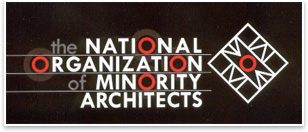
|
NOMA Receives Whitney Young Jr. Award
NOMA’s nomination was submitted by the Boston Society of Architects and supported by six previous Whitney M. Young Jr. Award recipients. In her letter of nomination, Jane Weinzapfel, FAIA, partner of the 2007 AIA Firm Award recipient Leers Weinzapfel, writes, “Although we have repeatedly acknowledged the relative homogeneity of our profession and our commitment to diversify it, we have failed to [increase significantly the number of African-American architects].” Thirty-eight years after Young’s call for action and 35 years after its creation, NOMA was selected for its unfailing dedication to promoting the architecture profession with the goal of increasing diversity among practitioners. Preeminent voice for minority architects “NOMA has given greater visibility to African-American architects, provided ‘role-models’ for students, and informed the general public,” says J. Max Bond, FAIA, in his letter of support for NOMA. “Through the establishment of student chapters and by inviting students to attend its meetings, NOMA has helped young people learn about and become members of the profession.” Indeed, NOMA’s commitment to students of color interested in pursuing careers in architecture may prove to be the organization’s greatest legacy. NOMA’s commitment to students of color interested in pursuing careers in architecture may prove to be the organization’s greatest legacy The annual National Organization of Minority Architects Students (NOMAS) Student Design Competition has become the coveted award among minority architecture students across the country. The unique program highlights a cultural aspect, historic figure, or significant location that likely won’t be found in other design competitions, but the camaraderie and interaction among other architecture students and professionals is the compelling factor. The NOMA Conference provides students the opportunity to interact with professional architects for portfolio review, advice, internships, and career guidance. Conference seminars offer interns insight on the Architecture Registration Exam, Intern Development Program, portfolio development, interview skills, and resume writing. NOMA also has held a regional ARE preparation program for interns. Career choice awareness Today we are present and accountable in the AIA “Architectural students of color gravitate to NOMA because of its sensitivity to their needs,” says Leon Bridges, FAIA, FNOMA, in his letter of support. “NOMA’s membership is small, but its striving for excellence for minority architects continues to increase in its intensity. NOMA’s mere presence provides hope to hundreds of graduating minority architects for their inclusion in an otherwise, still, white-dominated profession.” Adds NOMA cofounder Van B. Bruner Jr., FAIA: “Over 30 years have [passed] now and NOMA has and is realizing those goals created by the group in the ’70s. Today we are present and accountable in the AIA. Our dream has taken flight. We have contributed to the AIA and America a segment of our society that would have been lost were it not for NOMA.” |
||
Copyright 2006 The American Institute of Architects. All rights reserved. Home Page |
||
home
news headlines
practice
business
design
Recent related
› Purnell Elected 2008 President
› DIVERSITY: The Trailblazers
› DIVERSITY: What the Numbers Tell Us

 Summary:
Summary: